Labor Department rule stabilizes farmworker wage rate
Final rule updates methodology for determining annual Adverse Effect Wage Rates in H-2A visa program.

The U.S. Department of Labor announced Monday that it will stabilize the wages paid to guest farmworkers. The Adverse Effect Wage Rate (AEWR) will remain at 2020 levels for the next two years.
The final rule updates the methodology for determining the annual AEWR in the H-2A visa program, improves the consistency of the AEWR, provides stronger protections for workers and establishes better stability and predictability for employers in complying with their wage obligations.
“Over the past several years, farm wages have increased at a higher pace than other industries, which is why this DOL rule could not come at a better time,” Agriculture Secretary Sonny Perdue said. “This is an example of good government that will ensure greater stability for farmers and help them make long-term business decisions rather than facing uncertainty year after year.”
For the vast majority of agricultural jobs, the rule stabilizes the wage rate through calendar year 2022 by using the average hourly wages for field and livestock workers (combined) -- published in the U.S. Department of Agriculture’s "Farm Labor Survey" in November 2019 -- as the AEWR for field and livestock worker occupations. Beginning in 2023 and annually thereafter, DOL will adjust these AEWRs by the percentage change in the Bureau of Labor Statistics’ (BLS) Employment Cost Index for wages and salaries for the preceding 12-month period.
For all other agricultural jobs, DOL will set and annually adjust the AEWR using the average hourly wages for the occupational classification reported by the BLS Occupational Employment Statistics Survey program. These agricultural jobs are often supervisory or require greater or unique skills, such as construction jobs, which pay higher wages than typical farming occupations.
The changes implemented in this rule also address stakeholder concerns about the potential for significant and unpredictable wage changes from year to year associated with DOL’s prior AEWR methodology while ensuring better wage protections for U.S. workers similarly employed in more highly skilled agricultural jobs. More predictable wage adjustments in the H-2A program will help American farmers plan and budget for their workforce needs and ensure that wages in the H-2A program keep pace with steadily increasing wages in the wider economy.
DOL intends to issue a second final rule to finalize the remainder of the July 29, 2019, proposed rule that will govern other aspects of the certification of agricultural labor or services performed by H-2A workers and enforcement of the contractual obligations applicable to employers of such nonimmigrant workers.
American Farm Bureau Federation president Zippy Duvall stated, “Farmers are committed to paying their employees a fair wage, but the existing system sets unpredictable rates that make it hard for farmers to remain competitive. The Department of Labor’s decision to maintain current pay rates for the next two years for the majority of H-2A employers provides stability during the uncertainty created by the pandemic and trade imbalances.
“While this decision does not solve all of the wage issues, it is a step in the right direction. We look forward to continuing our work on meaningful agricultural labor reform through the regulatory or legislative processes,” Duvall added.
About the Author(s)
You May Also Like





